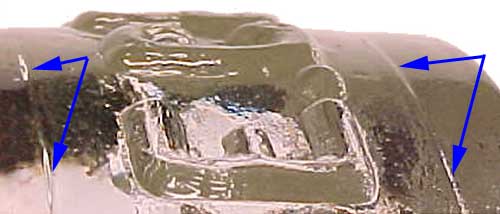[ Home | What's New | Articles ]
By Howard Banks![]() November 2002
November 2002
Collectors have asked for a quick way to identify the suspect imitation EC&M insulators. The color of the glass, by itself, isn't sufficient. A number of suspect CD 123's are found in traditional aqua coloration. Taking measurements will clearly separate genuine from the suspect pieces, but not everyone carries a tape measure and a set of calipers to insulator shows and antique shops.
The following visual clue the will quickly tell you if the EC&M you are looking at is one of the suspect imitation EC&M's now being investigated by the National Insulator Association.
Look for evidence of "mold lines" above and below the embossing. In the suspect pieces, the embossing appears to have been added to the mold with what is called a "slug plate". The "slug" is a strip of metal placed into a groove that was pre-formed on one side of the mold. The insertion of this strip of metal leaves a mark, or "mold line", in the glass when the suspect imitation is poured.

No genuine EC&M insulator is known to have these marks above and below the embossing. Some genuine EC&M mold styles have slug plates, but they are always on the reverse of the insulator. They were apparently used to COVER UP an embossing error in the mold, and were not the method for forming the embossing.
I have identified 14 major mold variations in EC&M's. Four of the suspect styles have these "mold lines" above and below the embossing. A fifth suspect style has a thick projection of glass where the embossing is traditionally found. Instead of the letters "E.C&M Co S.F.", the embossing consists only of backward formed numerals "54". This suspected imitation was apparently created in a recently manufactured mold by pouring the insulator without the slug plate in place.
There are numerous other characteristics by which the suspected imitations fail to match genuine EC&M insulators: Style of lettering; length of embossing; position of the button; location of the glass bead at the top of the pin hole; style, shape and size of threads; and even the overall shape of the "insulator".
Full descriptions of the various EC&M molds will be detailed in a full color insert in the January 2003 edition of Crown Jewels of the Wire.
Note: The opinions expressed here are those of
Howard Banks
and do not necessarily reflect the opinions of the Webmaster or www.insulators.info
![]() Return to the Research Articles
page
Return to the Research Articles
page
If you have questions or comments, please use this Feedback Form.
Last updated Saturday, November 9, 2002